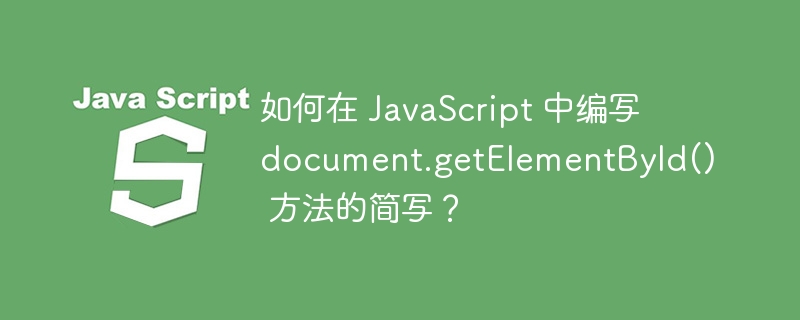所属分类:web前端开发

document.getElementById() 方法允许我们在 JavaScript 中使用其 id 来访问任何 HTML 元素。每个网页只能包含具有单个 id 的单个 HTML 元素。
您可以使用下面的示例代码通过其 id 访问任何 HTML 元素。
let element = document.getElementById('id');
在上面的代码中,我们使用了文档对象的getElementById()方法,并将id作为参数传递。
现在,如果我们需要使用 id 访问多个元素,那么使用 document.getElementById() 并不是一个好主意,但我们可以为其创建一个简写并使用它。
您可以按照以下方法为 document.getElementById() 方法创建简写。
最简单的解决方案是使用箭头函数为 document.getElementById() 方法创建简写。我们可以创建一个箭头函数,以 id 作为参数,并在箭头函数体中使用 document.getElementById() 方法访问元素后返回该元素。
您可以按照下面的语法使用箭头或匿名函数来编写 document.getElementById() 方法的简写。
let get = (id) => document.getElementById(id);
let element = get('element_id');
在上面的语法中,我们创建了 get() 箭头函数,它以 id 作为参数,使用 document.getElementById() 方法和 id 访问元素,然后返回它。
在下面的示例中,我们使用匿名箭头函数为 document.getElementById() 方法创建简写。在代码中,用户可以观察到我们不需要每次使用 id 访问元素时都编写“document.getElementById()”,因为我们可以使用 get() 函数
<html>
<body>
<h3>Using the arrow or anonymous functions to write shorthand for document.getElementById() method in JavaScript </h3>
<div id = "output"> </div> <br>
<div id = "test"> </div>
<script>
let get = (id) => document.getElementById(id);
let output = get('output');
output.innerHTML += "This text is written in the div with id equal to output. <br>";
let test = get('test');
test.innerHTML += "This text is written in the div with an id equal to the test. <br>";
</script>
</body>
</html>
在 JavaScript 中,大多数事物都是对象,每个对象都包含其原型。同样,原型也是一个包含创建原型链的原型的对象。我们可以向对象的原型添加方法或属性并可以使用它。在这里,我们将使用“document.getElementById”值向“document”对象添加一个属性。之后,我们可以使用该属性通过 id 访问元素。
用户可以按照以下语法使用对象原型编写 document.getElementById() 方法的简写。
HTMLDocument.prototype.get = document.getElementById;
let output = document.get('output');
在上面的语法中,我们使用“HTMLDocument”对象来访问文档对象的原型。我们已将“get”属性添加到文档对象中。
在下面的示例中,我们将“get”属性添加到 HTML 文档对象,并将 document.getElementById() 方法指定为值。
现在,我们可以使用“document”对象(如“document.get()”)访问 get 属性。我们可以将 id 作为“get”属性的参数传递,以通过 id 访问元素。
<html>
<body>
<h3>Using the <i> object prototypes </i> to write shorthand for document.getElementById() method in JavaScript </h3>
<div id = "output"> </div>
<div id = "test"> </div>
<script>
HTMLDocument.prototype.get = document.getElementById;
let output = document.get('output');
output.innerHTML += "The output div accessed by id using the get prototype. <br>";
let test = document.get('test');
output.innerHTML += "The test div accessed by id using the get prototype. <br>";
</script>
</body>
</html>
jQuery 是一个 JavaScript 库,允许我们编写更具可读性的 JavaScript 代码。我们可以使用 jQuery 的“$()”元素访问器通过其 id 来访问 HTML 元素。
用户可以按照以下语法使用 JQuery 编写 document.getElementById() 方法的简写。
$('#id')
在上面的语法中,我们使用“#”字符来通过其 id 来访问元素。
在下面的示例中,我们在
标记中添加了 JQuery CDN,以便在 HTML 中使用 JQuery。我们在 HTML 中创建了“div”元素。在 JQuery 中,我们使用“$()”访问器来访问具有 id 的元素。 “#”字符指定用户想要通过 id 访问该元素。<html>
<head>
<script src = "https://cdnjs.cloudflare.com/ajax/libs/jquery/3.6.3/jquery.min.js"></script>
</head>
<body>
<h3>Using the <i> jQuery</i> to write shorthand for document.getElementById() method in JavaScript </h3>
<div id = "test"> </div>
<script>
$('#test').html('This div is accessed via id using jQuery.');
</script>
</body>
</html>
用户学会了使用各种方法编写 document.getElementById() 方法的简写。 JQuery 提供了一种简单而简短的代码格式来使用 id 访问元素。如果用户想使用 JavaScript,他们可以根据自己的习惯使用箭头函数或记录对象的原型。